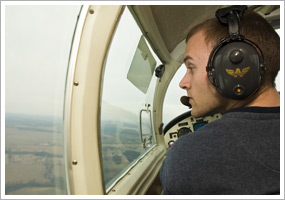training tips  ‘Track’ is key ‘Track’ is key The Feb. 11 Training Tip presented a sample knowledge test question on a radar traffic advisory issued to a pilot flying northbound in a calm wind:
“TRAFFIC 9 O`CLOCK, 2 MILES, SOUTHBOUND...”
Where should the pilot look for this traffic?
A) South.
B) North.
C) West. Answer: The northbound pilot would look west (at the 9 o’clock position, off the left wing tip) to spot the traffic. And because the reported traffic is already off your wing tip at a distance of two miles, headed in the opposite direction from you, no conflict exists. But you should still scan for it and advise ATC that you are looking for the traffic. Why did the question include the condition of a calm wind? Depending on the winds aloft, the pilot receiving the traffic advisory might be flying with a wind correction angle. That would affect whether the traffic appeared at the 9 o’clock point or another position as seen from the cockpit. The air traffic controller issuing advisories does not know the winds aloft. “Since the radar controller can only observe aircraft track (course) on the radar display, traffic advisories are issued accordingly, and pilots should give due consideration to this fact when looking for reported traffic,” explains Section 4-1-15 of the Aeronautical Information Manual. See the illustrations of induced error in the position of traffic. Aircraft track is discussed in Chapter 15 of the Pilot’s Handbook of Aeronautical Knowledge. “The direction in which the aircraft is pointing as it flies is heading. Its actual path over the ground, which is a combination of the motion of the aircraft and the motion of the air, is its track. The angle between the heading and the track is drift angle.” Whenever heading and track differ, expand the area you scan when ATC calls traffic. “Whether or not you see the traffic, keep looking,” wrote Robert I. Snow in “VFR traffic advisories” on the Flight Training website. “One time the traffic may pass 6 miles away and never be seen. The next time, however, the traffic may turn toward you and pass very close, and thanks to the controller's advisory, you'll already be looking for him.” Looking for traffic is a pilot’s duty. Knowing where to look takes skill. training products ‘So You Want to Fly Seaplanes’ app You’ve been hearing all about floatplane flying from your friends and wondering what the fuss is about. Sporty’s Pilot Shop’s new app, So You Want to Fly Seaplanes, takes you to one of the best-known havens for floatplane instruction: Jack Brown’s Seaplane Base in Florida. Fourteen video segments are used to help illustrate the maneuvers required for the FAA checkride, taxi techniques, and water takeoffs and landings. The app may be used on the iPhone, iPod Touch, and iPad. It sells for $29.99. Note: Products listed have not been evaluated by ePilot editors unless otherwise noted. AOPA assumes no responsibility for products or services listed or for claims or actions by manufacturers or vendors. final exam Question: Where can I find the location of a VOR receiver checkpoint? Answer: An FAA VOR test facility (VOT) transmits a test signal that provides users a convenient means to determine the operational status and accuracy of a VOR receiver. Checkpoints consist of certified radials that should be received at specific points on the airport surface or over specific landmarks while airborne in the immediate vicinity of an airport. Information on how to conduct a VOR receiver check is provided in Section 1-1-4 of the Aeronautical Information Manual. Locations of VOR test facilities are given in the airport/facility directory. Ground and airborne checkpoints are listed by state and airport. Other options for performing a VOR equipment check are listed in FAR 91.171. Got a question for our technical services staff? E-mail [email protected] or call the Pilot Information Center, 800/872-2672. Don’t forget the online archive of “Final Exam” questions and answers, searchable by keyword or topic. |  ‘Track’ is key
‘Track’ is key

